Research - (2022) Volume 10, Issue 5
Phytochemical Analysis, Antioxidant and Anti-Diabetic Activity of Sargassum wightii (A Marine Alga)
*Correspondence: C Naveen Kumar, Department of Microbiology, Sri Lakshmi Narayana Institute of Medical Sciences affiliated to Bharath Institute of Higher Education and Research, Chennai, Tamil Nadu, India, Email:
Abstract
The edible seaweed, Sargassum wightii, was investigated for its anti-diabetic potential through in vitro enzyme inhibitory assays. Among the various extracts, extracts of petroleum ether and Syl ethyl acetate. Wightii showed significant inhibitory effects against α-amylase. Methanol extract for S. wightii showed very high inhibition against dipeptidyl peptidase and moderate antioxidant activity was observed in the release of acetone S. wightii. Similarly, the hexyen extract of S. polycystum showed very high inhibition against α-amylase and S-extract methanol. Polycystum inhibition significantly against α-glycosidase as well. The antioxidant activity was negative. Exit was investigated with in vitro cytotoxicity, DNA fragmentation in macrophages and hemolytic activity against erythrocytes, but no significant toxicity was detected by any of the extracts. Gas chromatography – mass spectrometry reveals the presence of anti-diabetic compound fucosterol and other major bioactive compounds, providing insight into the anti-diabetic and antioxidant properties of this compound. This study revealed possible mechanisms of anti-diabetic in vitro action, and these two marine plants may have anti-diabetic action in vivo. Seaweed, that is, the great seaweed, comprises a group of photosynthetic plants, which it is believed that evolution did not extend to the earth's vegetation. In general, the morphology of algae is much simpler than that of plant plants. There is a limited variety of functional cells and, indeed, many known unicellular algae are scientifically related to marine plants. To date as algae metabolism has been studied, it appears to be similar in many ways to earthy plants, although the final metabolic product may be different.
Keywords
Sargassum wightii, Phenol, Flavonoid, Carbohydrate, Pigment content, α-Amylase
Introduction
The most accessible marine resource in the coastal zone is marine macro algae, which has the potential to be an important source of biological compounds. The relevance of algae in the pharmaceutical industry is widely known across the world, and great attempts have been made to extract chemicals from algae. There are numerous reports from throughout the globe on the therapeutic use of seaweeds belonging to the Phaeophyceae, Rhodophyceae, and Chlorophyceae families. Many parts of the world, particularly India, rely on marine macro algae for both ecological and commercial reasons. Algae are a kind of plant that includes seaweeds. Seaweeds are divided into three groups based on their nutritional and chemical composition: Rhodophyta (red algae), Phaeophyta (brown algae), and Chlorophyta (green algae).
Their usage as food in India is quite restricted. Protein, minerals, dietary fibres, vitamins, vital amino acids, and essential fatty acids are all found in seaweeds. Furthermore, seaweeds may include bioactive chemicals that have anti-diabetic activities. Because they contain carotenoids, dietary fibres, proteins, vital fatty acids, vitamins, and minerals, they have been utilized as food in India for millennia. They are the most nutrient-dense and vitamin-dense foods on the planet. They're also one of nature's most abundant sources of vegetable protein, with a wide range of carotenes, chlorophyll, enzymes, amino acids, and fibre. In the pharmaceutical sector, several algae species have been utilized to extract phycocolloids (align, carrageenan, and agar) and as a source of medicinal compounds. Marine algae are mostly used for the industrial manufacturing of phycocolloids like agar-agar, alginate, and carrageenan, rather than for health reasons. They might be a source of bioactive metabolites for medication development in the pharmaceutical sector. Secondary metabolites found in seaweeds, such as alkaloids, phenols, flavonoids, Saponins, steroids, and related active metabolites, have significant medical potential and have been widely exploited in the medicine and pharmaceutical industries. Seaweeds are thought to be a source of bioactive chemicals since they may create a wide range of secondary metabolites with a wide range of biological activity.
Brown, red, and green algae have been shown to have compounds having antioxidant, antiviral, antifungal, and antibacterial properties [1-3]. Amino acids, terpenoids, phlorotannins, steroid hormones, phenolic chemicals, halogenated ketones, alkanes, and cyclic polysulphides are all found in algae. The phenolic chemical phlorotannins is one of brown algae's bioactive metabolites. Antifouling, antioxidant, and anti-plasmin inhibitor are all functions of phlorotannins in the environment. They're a good source of bioactive natural compounds. Seaweed secondary metabolites have a wide range of bioactivity, from neuro active in humans to algicidal, nematicidal, insecticidal, and ichthyotoxic in lower animals. Steroids are thought to be a biosynthetic precursor for cardenolides in plants, and they may act as an intermediary in the production of downstream secondary natural products. Marine algae have been demonstrated to be an excellent source of non-toxic, unsaponifiable sterols with therapeutic significance. The antioxidant content of marine algae is thought to be rather high. Some pigments (e.g. fucoxanthin, astaxanthin, carotenoid) and polyphenols (e.g. phenolic acid, flavonoid, and tannins) were found as possible antioxidant chemicals. Marine algae are a significant source of bioactive chemicals with a wide range of biological activity. Their value as a source of new bioactive molecules has recently increased, and researchers have shown that compounds derived from marine algae have a wide range of biological activity.
Materials and Methods
Phytochemical analysis of different solvent extracts The phytochemical analysis of methanol, acetone and aqueous extract from selected algae were screened for the presence or absence of active secondary metabolites such as Saponins, Terpenoids, Tannin, Steroid, Glycoside, Alkaloid, Flavonoid, Phlobatannin, Anthraquinone and Phenol. General reaction in this analysis revealed the presence or absence of the compounds in the plant extracts in following procedures. The qualitative phytochemicals of the extracts were determined as reported by Aiyelaagbe and Osamudiamen (2009) [2], Egwaikhide et al. (2007) and Mariita et al. (2010).
Estimation of phenol by Sadasivam and Manickam, (1992), Flavonoid determination by the method of Bohm and Kocipai-Abyazan (1994), Antioxidant assay DPPH (Mensor at 2001), Estimation of carbohydrate by Dubois (1956), chlorophyll by Arnon, (1949), protein by Lowry (1951) and anti-diabetic assay α-amylase test, K. Suthindhiran & M.A. Jayasri (2015) [4].
A total number of 38 marine macro algae were collected from the kovalam coastal area in Chennai city during the study period. Macro algae were selected for phytochemical and biochemical studies. Then the collected algae were washed thoroughly with seawater to remove extraneous materials and brought to the laboratory in plastic bags containing water to prevent evaporation. The cleaned fresh materials were cut into small pieces and spread on blotting paper to remove excess water
Preparation of the extractions
The fresh materials were dried in the shade, and the dried materials were pulverized to get coarse powder. Separately, the coarse powdered material was extracted with methanol, distilled water, and acetone using the Soxhlet equipment. In a rotary evaporator, the extracts were collected and concentrated. For later usage, the concentrated extracts were kept in the refrigerator in airtight containers.
Results and Discussion
Marine algae might be a rich source of highly bioactive secondary metabolites, which could be important in the creation of novel pharmacological drugs. Seaweeds that are medicinal and high in secondary metabolites such as alkaloids, phenols, flavonoids, Saponins, steroids, and related active metabolites have a long history of usage in the pharmaceutical and medicine industries [3]. The Phyto constituents of marine algae populations in various locales have received a lot of study in recent years. For the qualitative analysis, three solvents were employed in this study: methanol, hexyen, and water extracts of Sargassum wightii. The presence of numerous secondary metabolites in these seaweeds is clearly demonstrated in this extract, indicating their medicinal potential.
The presence of tannin, steroid, alkaloid, flavonoid, Anthraquinone, Saponins, and phenol in solvent extracts was discovered by phytochemical analysis, suggesting that they may suppress bacterial infections. Seaweeds have long been thought to be a source of bioactive compounds, and they generate a wide range of secondary metabolites. The phytochemical examination of Gelidium acerosa extracts in methanol, hexyen, and water revealed the presence of alkaloids, polysaccharides, Saponins, flavonoids, and tannins.
The brown algal Sargassum wightii was found to have the highest levels of steroids in methanol, hexyen, benzene, and chloroform extracts. The presence of steroids, phenolic groups, Saponins, tannin, flavonoid, carbohydrate, alkaloid, glycoside, and protein in the algae Sargassum wightii was discovered in this study.
All algae contain the compounds terpenoids, tannin, steroid, alkaloid, flavonoid, Anthraquinone, and phenol. Acetone and methanol were used to dissolve the most antibiotic substance. Carbohydrates are the most significant component of metabolism because they provide energy for respiration and other metabolic activities. Rhodophycean members had the highest carbohydrate content, followed by Phaeophycean and Chlorophycean members.
In the present study, the Chlorophycean members showed high carbohydrate content than Rhodophyceae and Phaeophycean members. Maximum carbohydrate content was observed in sargassum wightii and the minimum carbohydrate content was found in Hypnea musciformis. The carbohydrate content of Padina tetrastromatica showed higher values than the earlier studies. The Rhodophycean members showed high carbohydrate content than Chlorophyceae and Phaeophyceae members.
In this study, the maximum protein was found in Sargassum wightii and low protein content was recorded in Hypnea musciformis. This finding was correlates with the study made on the biochemical composition of seaweeds.
These biochemical characteristic make the seaweed neutraceutical in nature and therefore they are important as food supplement in order to give good health and resist disease [5,6]. Tannins have been found to have antiviral, antibacterial anti-parasitic effects, antiinflammatory, antiulcer and antioxidant property for possible therapeutic applications. Tannins are known to possess general antimicrobial and antioxidant activities. At low concentration, tannins can inhibit the growth of microorganisms and act as an antifungal agent at higher concentration by coagulating the protoplasm of the microorganism. The amount the tannin content was maximum in Padina tetrastromatica and low amount in Hypnea musciformis.
The phenolic are found to play a greater role in the maintenance of the human body. These phenolics which include phenol, tannin and flavonoids have been found to be present in appreciable amount in all the selected macro algae. In the present study the highest total phenol and flavonoid was in the brown seaweed Sargassum wightii [7,8].
Screened four brown seaweeds from Tuticorin coast for their phenol content and reported highest value in Padina tetrastromatica. Phenolic compounds are widely distributed in the plant kingdom and have several biological activities including antioxidant properties [9].
Flavonoids are known as nature’s tender drug which possesses numerous biological and pharmacological activities. Recent reports of antiviral, anti-fungal, antioxidant, anti-inflammatory, antiallergenic, antithrombic, anticarcenogenic, Hepato protective and cytotoxic activities of flavonoids have generated interest in studies of flavonoid containing plants. In the present study the high amount of phenol and flavonoid were in the brown seaweed Sargassum wightii. The phytochemical screening of seaweeds showed the presence of alkaloids, tannin, steroid, Saponins, Phlobatannin, flavonoids, phenol, Anthraquinone, terpenoids, and glycosides in all seaweed samples tested. The present investigation brings out adequate data on the phytochemical composition, photosynthetic pigments and antibacterial potential of three seaweed extract for synthesis novel antibiotic. Thus these seaweeds could be collected and utilized effectively in product preparation for the beneficial of mankind. Further research studies carried out on the other species of seaweeds from the same habitat in order to provide complete data on the nutritive and antimicrobial potential of these algae (Figure 1-5).
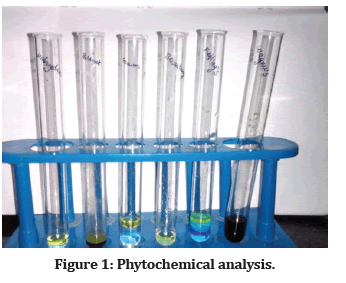
Figure 1: Phytochemical analysis.
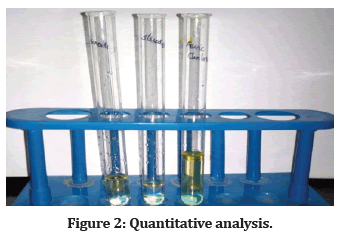
Figure 2: Quantitative analysis.
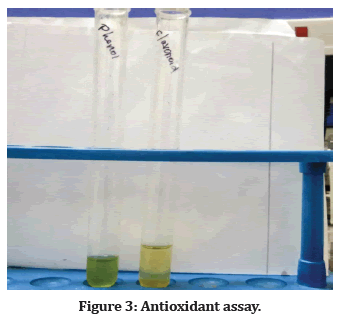
Figure 3:Antioxidant assay.
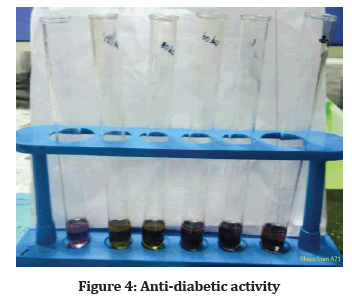
Figure 4:Anti-diabetic activity.
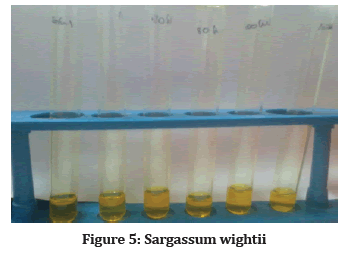
Figure 5:Sargassum wightii.
The different solvents extract from Sargassum wightii revealed the presence of tannin, steroid, alkaloid, phenol, flavonoid, terpenoids and the compounds Phlobatannin, Saponins, glycoside were given negative result. Alkaloid, tannin and phenol were present in all the three solvent extracts. The positive results were observed for tannin, alkaloid, Anthraquinone, phenol, flavonoid in acetone extract. The compounds steroids, Phlobatannin, Saponins, glycoside, terpenoids were not observed in acetone extract. The methanol extract showed the presence of tannin, steroid, alkaloid, phenol, flavonoid and terpenoids. The compounds Phlobatannin, Saponins, Anthraquinone, glycoside were given negative results. The aqueous extract shows the presence of tannin; alkaloid, phenol, Anthraquinone and the compounds like steroid, Saponins, glycoside, Phlobatannin and terpenoids were absent (Table 1).
| Sl. No | Name of the compound | Methanol | Hexyne | Water |
|---|---|---|---|---|
| 1 | Alkaloid (Wagner’s test) | + | + | + |
| 2 | Carbohydrate (Fehling's test) | + | + | + |
| 3 | Glycoside (Borntrager’s test) | _ | + | _ |
| 4 | Saponins (Fome test) | + | _ | + |
| 5 | Proteins (Biuret test | _ | + | + |
| 6 | Amino acid (Ninhydrin test) | _ | _ | + |
| 7 | phenol (Ferric chloride test) | + | + | + |
| 8 | Terpenoids Test | + | + | + |
| 9 | Steroids Test | + | + | + |
Note: + present - absent.
Table 1: Phytochemical screening of different table.
Antioxidant assay
The free radical scavenging activity of seaweed extracts was measured according to the method. In brief, 100μl of a methanolic solution of 1,1-diphenyl- 2-picrylhydrazyl (DPPH; Himedia, Mumbai, India) was added to test samples of various concentrations(20– 100μg/ml). Samples were incubated in the dark for 20 min and reduction of DPPH concentration (20–100μg/ ml). Samples were incubated in the dark for 20 min and reduction of DPPH concentration was measured at 517nm in an ultraviolet (UV)–visible spectrophotometer (Table 2).
| S.no | Concentration (mg/ml) | OD value | A. A% |
|---|---|---|---|
| 1 | Control | 0 | 0.968 |
| 2 | 20μl | 9.504 | 0.876 |
| 3 | 40μl | 20.24 | 0.772 |
| 4 | 60μl | 26.65 | 0.71 |
| 5 | 80μl | 32.02 | 0.658 |
| 6 | 100μl | 39.56 | 0.585 |
Table 2: Antioxidant assay (DPPH).
Anti-diabetic activity
α-amylase test
Algae sample was taken in various concentrations at 20, 40μl, 60μl, 80μl, 100μl and control in test tubes 250μl of α-amylase is added in each in each test tube and mixed. Each test tube was incubated at room temperature. Then 500μl of starch was added and incubated for 3 minutes at room temperature. 500μl of DNS was added and kept at water bath at 50degreeC for 5 minutes. The Antidiabetic activity was read at 540nm in UV. Spec (Table 3).
| S.no | Concentration (mg/ml) | OD value | Anti-diabetic Activity % |
|---|---|---|---|
| 1 | control | 0.169 | 0 |
| 2 | 20μl | 0.176 | 4.142 |
| 3 | 40μl | 0.188 | 11.24 |
| 4 | 60μl | 0.189 | 11.83 |
| 5 | 80μl | 0.21 | 24.26 |
| 6 | 100μl | 0.262 | 55.02 |
Table 3: Anti-diabetic activity.
Conclusion
From the result it can be concluded that the solvent extracts of Sargassum wightii showed the presence of number of metabolites. Padina tetrastromatica examined rich sources of phytochemicals particularly flavonoids, tannins, alkaloids, phenol which can be isolated and further screened for different kinds of biological activities, depending on their reported therapeutic uses. The active metabolites are of great medicinal value and have been extensively used in the drug and pharmaceutical industry. Thus the present studies on phytochemical analysis can help the manufacturers for identification and selection of raw materials for drug production.
Funding
No funding sources.
Conflict of Interest
The authors declare no conflict of interest.
Acknowledgements
The encouragement and support from Bharath Institute of Higher Education and Research, Chennai, Tamil Nadu, India is gratefully acknowledged for providing the laboratory facilities to carry out the research work.
References
- Agoramoorthy G, Chandrasekaran M, Venkatesalu V, et al. Antibacterial and antifungal activities of fatty acid methyl esters of the blind-your-eye mangrove from India. Br J Microbiol 2007; 38:739-42.
- Al-masri IM, Mohammad MK, Tahaa MO. Inhibition of dipeptidyl peptidase IV (DPP IV) is one of the mechanisms explaining the hypoglycemic effect of berberine. J Enzyme Inhib Med Chem 2009; 24:1061-6.
- Huang HL, Wang BG. Antioxidant capacity and lipophilic content of seaweeds collected from the Qingdao coastline. J Agric Food Chem 2004; 52:4993-7.
- Jayasri MA, Radha A, Mathew TL. α-amylase and α-glucosidase inhibitory activity of Costus pictus D. Don in the management of diabetes. J Herb Med Toxicol 2009; 3:91-4.
- Kwon YI, Apostolidis E, Kim YC, et al. Health benefits of traditional corn, beans, and pumpkin: in vitro studies for hyperglycemia and hypertension management. J Med Food 2007; 10:266-75.
- Lee YS, Shin KH, Kim BK, Lee S. Anti-Diabetic activities of fucosterol from Pelvetia siliquosa. Arch Pharm Res 2004; 27:1120-2.
- Liu L, Heinrich M, Myers S, et al. Towards a better understanding of medicinal uses of the brown seaweed Sargassum in Traditional Chinese Medicine: A phytochemical and pharmacological review. J Ethnopharmacol 2012; 142:591-619.
- Yuan YV, Carrington MF, Walsh NA. Extracts from dulse (Palmaria palmata) are effective antioxidants and inhibitors of cell proliferation in vitro. Food Chem Toxicol 2005; 43:1073-81.
- Wu XJ, Hansen C. Antioxidant capacity, phenolic content, and polysaccharide content of Lentinus edodes grown in whey permeate‐based submerged culture. J Food Sci 2008; 73:M1-8.
Indexed at, Google Scholar, Cross Ref
Indexed at, Google Scholar, Cross Ref
Indexed at, Google Scholar, Cross Ref
Indexed at, Google Scholar, Cross Ref
Indexed at, Google Scholar, Cross Ref
Indexed at, Google Scholar, Cross Ref
Indexed at, Google Scholar, Cross Ref
Author Info
Department of Microbiology, Sri Lakshmi Narayana Institute of Medical Sciences affiliated to Bharath Institute of Higher Education and Research, Chennai, Tamil Nadu, IndiaCitation: Sangiya K, C Naveen Kumar, Phytochemical Analysis, Phytochemical Analysis, Antioxidant and Anti-Diabetic Activity of Sargassum wightii (A Marine Alga), J Res Med Dent Sci, 2022, 10 (5):78-82.
Received: 25-Apr-2022, Manuscript No. JRMDS-22-59106; , Pre QC No. JRMDS-22-59106 (PQ); Editor assigned: 27-Apr-2022, Pre QC No. JRMDS-22-59106 (PQ); Reviewed: 10-May-2022, QC No. JRMDS-22-59106; Revised: 15-May-2022, Manuscript No. JRMDS-22-59106 (R); Published: 22-May-2022
